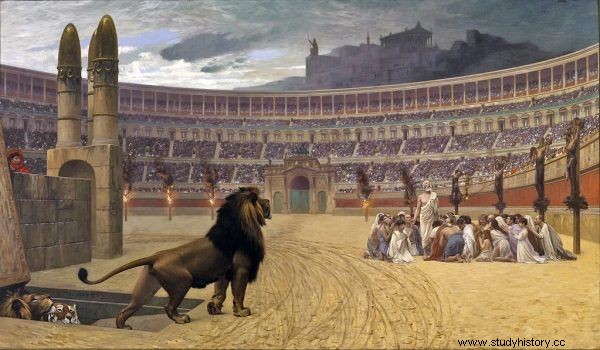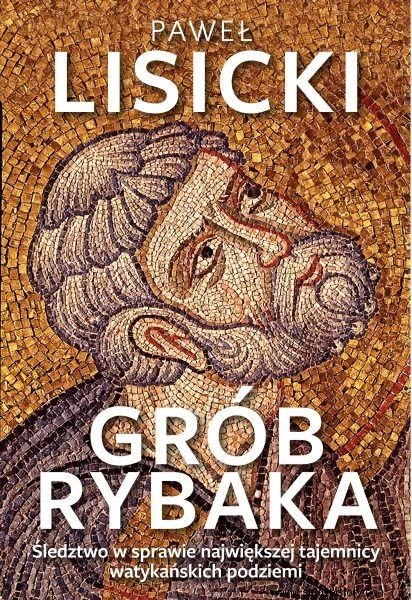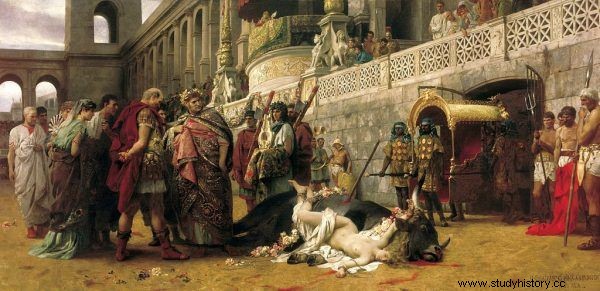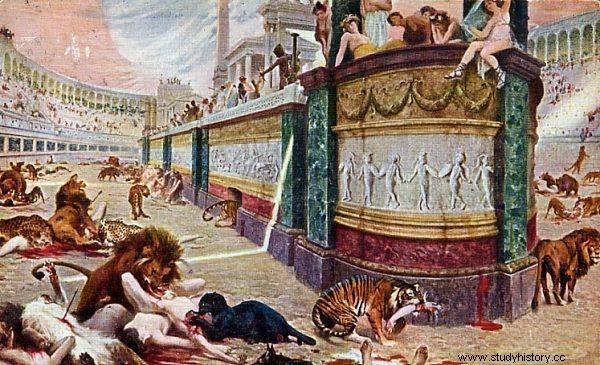Ancient Rome was not the best place to live for Christians. From the very beginning, they fell victim to persecution by religious opponents and the rulers of the empire. There were plenty of methods of killing the followers of the new faith, and the torturers were outdoing each other in ideas for "adequate" torment.
It all started in Jerusalem, where Saint Stephen tried to reform Judaism with his teachings. In this way he fell under the skin of the Sanhedrin - the Jewish High Council - who condemned the apostle to stoning in 36 C.E. "We heard him say that Jesus of Nazareth would destroy this place and change the habits that Moses handed down to us," the judges justified the harsh sentence.
Rather, they feared that their new faith might undermine their position. Therefore, they allowed the crowd to lead Stephen outside the city and execute him. The martyr, under a hail of bullets, is said to have asked Jesus for grace - both for himself and for the enraged executioners. Interestingly, today this saint is the patron saint of stonemasons ...
Political scapegoats
The innovations in faith proposed by the early Christians did not appeal to the then authorities of the Jewish community in Judea. The animosity between the followers of the new and old religions decided to use Herod Agrippa I, who wanted to win the favor of the local population. And since nothing unites as much as a common enemy, the king has just turned against Christ's followers Persecuting them to the point where most of them escaped by fleeing to Jerusalem - and beyond, to Europe.

The last prayer of Christian martyrs to be eaten by lions.
The ruler, in order to "show off" in front of the Jews, sentenced Saint James to death and planned to do the same with Saint Peter (according to traditional accounts, he miraculously managed to avoid execution). His strategy of eliminating Christian leaders had driven large numbers of the faithful out of the region. However, religious refugees had to go somewhere. They reached Phenicia, Cyprus and Antioch, and soon afterwards to Rome. Unfortunately, they did not find peace there…
It was in the capital of the empire in the second half of the 1st century AD, during the reign of Nero, that the period of the most intense persecution and the greatest cruelty towards the "heirs" of Christ's teachings began. But why was the emperor so concerned about the persecuted refugees from Judea? He wasn't that negative about them at first… It was a political cause. As we read in the book "The fisherman's grave" by Paweł Lisicki:
How exactly to change the position towards Christians managed to convince Nero, it is not known. (...) Christians, unlike the Jews, carried out large-scale mission work among the Gentiles. While it was politically beneficial to support a new Jewish sect in Judea, it was quite another to let it operate and spread throughout Rome.
All the more so because by adopting Christianity, and therefore believing in Christ as Lord and Savior, the pagans could in principle be regarded as those who rejected the claims to divinity made increasingly explicit by Nero.

Learn the greatest secret of the Vatican underground thanks to the book by Paweł Lisicki, "The Fisherman's Tomb" (Fronda Publishing House 2019).
After the famous fire of Rome, the ruler had to clear his name. Giving people bread and oil was not enough - it was necessary to indicate the guilty party (not himself, of course). The Christians turned out to be an excellent target, and the people treated them with distrust anyway. Through torture, incriminating confessions were obtained. And since there was an excuse, another persecution could begin - this time much more elaborate and on a much larger scale.
One of the victims of Nero's anti-Christian campaign was Saint Paul, who was sentenced to death by beheading because of his Roman citizenship. He was very lucky - Saint Peter faced a much more cruel punishment. He died on the cross, hanged at his own request, however, not like Jesus, but upside down.
To the delight of the crowd
Nero transformed the executions of the followers of the Christian faith into real spectacles. His Hunger Games had to have a proper setting. As the first place of his execution, he used the stadium, the construction of which was started in the Vatican by Caligula around 40 AD. As reported by the Roman historian Tacitus:
And their deaths are a mockery that covered in the skins of wild animals, they died torn apart by dogs or nailed to crosses, or destined to be consumed by the flames ; when the day was gone, they burned as night torches. For this spectacle Nero offered his park and held games in the circus, where he mingled with the crowd in the guise of a coachman or stood on a cart.

A Christian martyred during the persecution under Emperor Nero.
The motive of setting the unfortunates on fire was supposed to derive from the "right of retribution" known to the citizens of the empire, that is to punish the guilty in exactly the same way as they were at fault. And since the Christians "set fire to Rome", the torturers - to the delight of the crowds - prepared a similar fate for them.
Today, however, it is difficult to state unequivocally what is true in the stories about the torments of the first followers of Jesus, and what is just a dramatized exaggeration. For example, according to some accounts, the faithful, condemned to torment, were to sing the song "Christus regnat" and calmly go to execution.
This version was suggested by, among others, Henryk Sienkiewicz when he wrote "Quo vadis", although according to contemporary historians, the author's vision does not fully correspond to reality . Moreover, although the Pope's Way of the Cross takes place in the Colosseum each year, there is no evidence that Christians died en masse there as well.
Nevertheless, the fact remains that many converts to the new religion have lost their lives because of it. Tacitus in his reports uses the term "great crowd" to refer to victims of persecution, most of whom were Jewish converts. Not all of them were killed during one of Nero's "shows". Some died of starvation or disease even before they were dragged from overcrowded prisons to the arena ...

The persecution of Christians in ancient Rome was inspired by Henryk Sienkiewicz, writing his novel "Quo vadis".
There is no peace without victims
Nero's death by no means ended the wave of persecution. However, it was impossible to kill for absolutely no reason, and setting Rome on fire was once again out of the question. So Christians began to be accused of more and more "varied" crimes - including ... atheism.
During the reign of Emperor Domitian the faithful who did not make sacrifices to their gods, in the light of the law did not profess any religion, and this was forbidden by law and severely punished for it. The alleged Christian rituals were also looked with a wry eye. For if you trust the rhetoric of that time, the "heirs" of Jesus formed secret societies, and during their meetings they organized orgies, drank the blood of babies, practiced magic and ... worshiped donkeys. Faced with such accusations, it is hardly surprising that ordinary Romans were suspicious of the followers of the new religion.
Although it was difficult to prove the truth of these suspicions, there were occasions in the middle of the second century when people, angered by these bestial (and imaginary) practices, attacked the homes of alleged Christians and robbed them of their fortune. Stoning has again become a popular method of getting rid of dissenters.
The example for gray citizens came from above - the authorities were also heavily involved in the persecution. For example, the reigning emperor Maximilian Trak in the 3rd century, in order to put an end to "illegal" religious practices, decided to imprison Christian clergy and punish people who did not publicly worship Roman gods. Those who objected could also be imprisoned and even sentenced to torture or death!

Learn the greatest secret of the Vatican underground thanks to the book by Paweł Lisicki, "The Fisherman's Tomb" (Fronda Publishing House 2019).
In turn, during the reign of Diocletian, privileges and freedom were deprived of all those who refused to offer sacrifices to the "old" gods. In 303, an edict destroyed Christian temples, burned books, and banned the new religion from organizing congregations . A year later, however, there were still some reluctant people who disagreed with the duress and suffered a martyr's death instead.
This was also, according to some historians, to paradoxically strengthen Christians in their faith. In the end, Jesus himself died, tormented on the cross, and after him, for spreading his teachings, the apostles died. Thus, at least some converts interpreted the persecution as following in the footsteps of the Savior. The Christian author Tertullian, who lived at the turn of the second and third centuries, lofty wrote:"In them the presence of Christ is made manifest." However, as Paweł Lisicki notes in "The Fisherman's Grave" :
It was not the desire for martyrdom that caused the persecution, but it was the persecution that brought the cult of martyrs . It is enough to read the thirteenth chapter carefully Paul's letter to the Romans or chapter two Of 1 Peter to see how much esteem and respect Christians placed in the Roman system and those in power.
It was not until 313 AD that the Edict of Milan put an end to the murder of Christians in ancient Rome, under which their religion was "legalized". Thanks to the new law proclaimed by Constantine the Great, who ruled over the western part of the empire, and Licinius who was in charge of the eastern part, Christianity soon became the universal religion. This does not mean, however, that political or religious conflicts never again affected the faithful - on the contrary, in some parts of the world they even affect them today!
Check where to buy the “Fisherman's Grave. Investigation into the greatest secret of the Vatican underground ":
